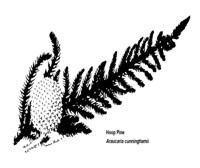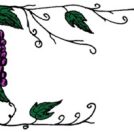PLANT OF THE MONTH June09
 Society for Growing Australian Plants –
Society for Growing Australian Plants –
PINE RIVERS BRANCH
PLANT OF THE MONTH – June, 2009
Melia azedarach
White Cedar, Persian Lilac, Chinaberry
Form: Melia azedarach is a deciduous, small shade tree with a rounded crown. It is a relatively fast grower that in cultivation can reach to 12m high with a spread of 6 to 8 metres, in natural conditions it can become a larger specimen. In the cooler months White Cedar is obvious in the forest for its seasonal foliage colour.
Foliage: White Cedar has decorative bi-pinnate fern like foliage which provides dense to dappled shade in summer. In autumn the leaves colour to a rich yellow gold – one of the few Australian trees to provide contrasting seasonal colour change. Keep a watch out for occasional invasion by the processional caterpillar which can defoliate a small tree almost overnight.
Flowering: The distinctive flowers, each with five pale mauve petals surrounding a 6mm dark purple tube of stamens, are produced in dense terminal clusters throughout the foliage canopy. The delicate and pleasant perfume pervades the surrounding area when in full bloom during autumn.
Fruiting: The spherical fleshy yellow fruit, 15mm in diameter, persist on the tree for several months through winter adding to the foliage colour effect. The seeds are reputed to be poisonous if ingested but birds eat the fruits and disperse the seed.
Suitability: This hardy frost and drought tolerant tree can adapt to a wide range of soil conditions and is best established in open sun but can tolerate partial shade. Formative pruning of juvenile specimens is beneficial to encourage a well shaped tree. White Cedar is often planted along streets and in parks to take advantage of the fragrant lilac flowers and yellow fruits of this appealing ornamental tree.
The next meetings / field trips
Meeting: Subject:
June 17 Winter in the Native Garden – Lawrie Smith
July 15 Saving the Franklin River, Tasmania;
The Wollemi Pine discovery
Excursions:
June 19 – 22 Road trip to Gladstone Tondoon Botanic Garden
July 19 Beerwah Forest Scientific Wallum Area
Lawrie Smith
Pine Rivers SGAP








